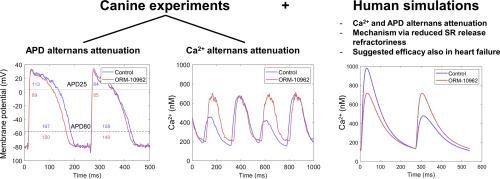Journal of Molecular and Cellular Cardiology ( IF 5 ) Pub Date : 2020-12-28 , DOI: 10.1016/j.yjmcc.2020.12.015 Jozefina Szlovák 1 , Jakub Tomek 2 , Xin Zhou 3 , Noémi Tóth 1 , Roland Veress 4 , Balázs Horváth 5 , Norbert Szentandrássy 4 , Jouko Levijoki 6 , Julius Gy Papp 7 , Neil Herring 8 , András Varró 7 , David A Eisner 9 , Blanca Rodriguez 3 , Norbert Nagy 7

|
Repolarization alternans, a periodic oscillation of long-short action potential duration, is an important source of arrhythmogenic substrate, although the mechanisms driving it are insufficiently understood. Despite its relevance as an arrhythmia precursor, there are no successful therapies able to target it specifically. We hypothesized that blockade of the sodium‑calcium exchanger (NCX) could inhibit alternans. The effects of the selective NCX blocker ORM-10962 were evaluated on action potentials measured with microelectrodes from canine papillary muscle preparations, and calcium transients measured using Fluo4-AM from isolated ventricular myocytes paced to evoke alternans. Computer simulations were used to obtain insight into the drug's mechanisms of action. ORM-10962 attenuated cardiac alternans, both in action potential duration and calcium transient amplitude. Three morphological types of alternans were observed, with differential response to ORM-10962 with regards to APD alternans attenuation. Analysis of APD restitution indicates that calcium oscillations underlie alternans formation. Furthermore, ORM-10962 did not markedly alter APD restitution, but increased post-repolarization refractoriness, which may be mediated by indirectly reduced L-type calcium current. Computer simulations reproduced alternans attenuation via ORM-10962, suggesting that it is acts by reducing sarcoplasmic reticulum release refractoriness. This results from the ORM-10962-induced sodium‑calcium exchanger block accompanied by an indirect reduction in L-type calcium current. Using a computer model of a heart failure cell, we furthermore demonstrate that the anti-alternans effect holds also for this disease, in which the risk of alternans is elevated. Targeting NCX may therefore be a useful anti-arrhythmic strategy to specifically prevent calcium driven alternans.
中文翻译:

通过 ORM-10962 阻断钠钙交换器可减弱心脏交替
复极交替是长短动作电位持续时间的周期性振荡,是致心律失常底物的重要来源,尽管其驱动机制尚不清楚。尽管它是心律失常的前兆,但目前还没有成功的疗法能够专门针对它。我们假设阻断钠钙交换器(NCX)可以抑制交替糖。选择性 NCX 阻滞剂 ORM-10962 对用微电极测量的犬乳头肌制剂的动作电位和使用 Fluo4-AM 从分离的心室肌细胞测量的钙瞬变进行评估,这些细胞起搏以诱发交替。使用计算机模拟来深入了解药物的作用机制。ORM-10962 减弱了心脏交替,包括动作电位持续时间和钙瞬变幅度。观察到三种形态类型的交替糖,在 APD 交替糖衰减方面对 ORM-10962 的反应不同。APD 恢复分析表明钙振荡是交替糖形成的基础。此外,ORM-10962 并没有显着改变 APD 恢复,但增加了复极后不应性,这可能是通过间接减少 L 型钙电流介导的。计算机模拟通过 ORM-10962 再现了交替糖的衰减,表明它是通过降低肌浆网释放不应性来起作用的。这是由于 ORM-10962 诱导的钠钙交换阻滞伴随着 L 型钙电流的间接减少所致。使用心力衰竭细胞的计算机模型,我们进一步证明抗交替糖效应也适用于这种疾病,其中交替糖的风险升高。因此,针对 NCX 可能是一种有用的抗心律失常策略,可专门预防钙驱动的交替。



























 京公网安备 11010802027423号
京公网安备 11010802027423号